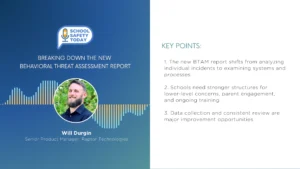Unlocking BVLOS: Expanding Drone Use Cases to New Horizons
As of 2022, the regulations in place monitoring and restricting drone operations within the U.S. air space have become a hindrance to maximizing the benefits of current drone technology. BVLOS, otherwise known as beyond the line of sight, flights are difficult, if not, nearly impossible to execute despite the potential for these flights to truly transform business operations.
“Right now beyond visual line of sight, BVLOS as we call it, is definitely a huge issue in our industry. For years now, drone operators, not just in the delivery sector but in the inspection sector and other places, were looking to really make the most of line of sight operations and it can be difficult because by definition the drone cannot go beyond the naked eye of the remote pilot in command,” said Grant Guillot, Drones in America Podcast Host.
The inability of the FAA to keep pace with the advancing technology is preventing the industry from moving forward. Everything from being able to deliver medicine and commercial goods, rescuing stranded individuals, surveying land after a wildfire, and every vision and dream in between, drones have the ability to positively impact human life and help businesses expand operations safely and effectively.
BVLOS Approval Essential to the Advancement of Drone Applications
“Opening up beyond visual line of sight with drones is really what’s going to unlock 99% of the market use cases. Drones have a number of applications, particularly in delivery that really only open when beyond visual line of sight becomes acceptable,” said Ryan Walsh, CEO of Valqari.
Currently, the Unmanned Aircraft Vehicle market is estimated to grow from approximately 27.9 billion in 2021 to 58.4 billion in 2026 (Intelligent HQ). The industry has expanded with the introduction of BVLOS but has not nearly reached its full potential.
Vivien Heriard-Dubreuil, CEO of Microdrones, spoke about the technology that is increasing drone capabilities such as batteries, gas engines, and fuel cells that are enabling drones to fly up to two hours. “It doesn’t make any sense just having it flying above you for a couple of minutes to map an area within the visual line of sight. We need BVLOS approval to actually leverage the technology of drones.”
The potential applications of BVLOS flights are virtually endless. In commercial applications alone there is package delivery; railroad, pipeline, powerline, windmill, and agricultural inspections; and mapping capabilities to name a few. From a government and public point of view, BVLOS has the potential to help public servants save lives and protect the environment. (UAV Coach)
FAA Struggling to Keep Pace with Technology
While the imagination can soar with possibilities, none of these applications will become a part of daily life until the FAA can develop a playbook of rules of regulations that will allow more companies to expand the use of drones. Currently, drones operate under Part 107 which was designed specifically for VLOS (visual line of sight) flights. Commercial and Tactical Beyond the Line of Sight (TBVLOS) waivers are available, but they are very difficult to acquire.
“There have been over 3600 certificates of waiver, Part 107 waivers issued since 2018 by the FAA. Only 99 of these have been for BVLOS. Interestingly enough, in the first four months of 2022, that’s when 33% of these were approved,” said Jason San Souci, Chief Architect at Juniper Unmanned.
Additionally, it’s interesting to note that there have been more than 1200 BVLOS waiver applications submitted to the FAA by commercial drone operators and 99% have failed to be approved. As for TBVLOS waivers, they are also very limited and only issued on a temporary basis for emergency situations in areas with low populations to ensure public safety.
One of the reasons for the strict limitations is the potential for collisions. “In terms of collision avoidance, the ability for a BVLOS operated vehicle to detect and avoid a potential collision with a non-cooperative intruder such as a rogue drone, a non-cooperative manned vehicle, or even a flock of birds, the BVLOS must have the ability to autonomously detect that threat, maneuver around it and continue with its primary mission,” explained Larry Surace, UAS, AAM Systems Architect, Honeywell Aerospace.
Other considerations include how to track drone operations and operators in the field. However, progress is on the horizon.
“What we are seeing is the FAA taking steps to think outside the box. Last summer they put together the BVLOS Aviation Rule Making Committee, or the BVLOS ARC, which contained a gathering of some of the biggest names in the industry, both crude and uncrude, and government stakeholders as well and they came up with five different categories of recommendations that were released in a final report [March 2022],” noted Guillot.
The Critical Role of Collaboration to Advance BVLOS Flights
The outcome of the BVLOS ARC committee illustrates the need for industry experts to work closely with the FAA. The need to create a system in which rules and regulations can keep up with the technology while keeping the national airspace safe is of the utmost importance.
“I think it’s incumbent upon industry to have a constant level of communication with the FAA showing them steady progression of not only BVLOS applications but also the safety associated with these operations. This would give the FAA confidence the industry is moving in the right direction safety-wise and therefore the FAA can expand the operational approvals for the BVLOS applications,” noted Surace.
Ensuring that the technology is evolving to address FAA concerns is critical to the industry moving forward. Ross Kenney, Account Executive at AirWorks, spoke about developing and implementing technology proposed by the FAA such as a remote ID, “a digital license plate for all drones in the sky.” He continued to note that these digital license plates would be able to transmit a variety of information including current location, location history, and operator status and location for example.
And Heriard-Dubreuil spoke about a potentially different approach that would allow for authorizations based on drone characteristics such as weight, payload, speed capabilities, and whether a drone is gas or battery powered. This could open the ability to increase use cases based on the potential dangers a drone poses.
BVLOS Benefits Driving Adoption
By creating the BVLOS ARC committee, the FAA has acknowledged the need to update regulations to advance the adoption of drone technology. Of course, there was no way to know that a global pandemic would speed up the development and implementation of such advanced technology. However, now that it’s here the benefits of doing so simply cannot be ignored.
From significantly reducing business costs to saving human life, the potential impact of BVLOS will not be fully known until regulations have been successfully advanced. While change is on the horizon, industry leaders and government officials will need to keep working together to further advance BVLOS applications.









